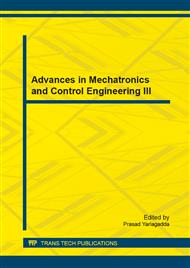p.406
p.410
p.417
p.423
p.429
p.436
p.447
p.452
p.456
A Method of Bionic Odor Source Spatial Positioning to Mobile Robot Based on Fuzzy Logic Algorithm
Abstract:
Presents a fuzzy logic inference algorithm based on the feature of concentration difference to solve the problem of odor source spatial positioning to mobile robot. The algorithm simulates the dynamic stimulation’s behavior of merit, let the robot to make decisions on the direction of travel by sensing the rate of change of concentration in different positions, and finally achieve the function of autonomous positioning to odor source. Let the robot's actual environment as the premise, design a fuzzy inference machine, and determine the fuzzy inference machine’s input variables, output variables, language value of input and output and corresponding fuzzy inference rules. Simulation results show that the proposed fuzzy logic algorithm has a strong applicability on bionic odor source spatial positioning to mobile robot; it can make the robot search to the odor source faster and more accurate.
Info:
Periodical:
Pages:
429-435
Citation:
Online since:
October 2014
Authors:
Price:
Сopyright:
© 2014 Trans Tech Publications Ltd. All Rights Reserved
Share:
Citation:


